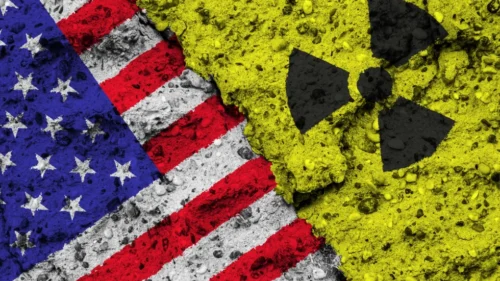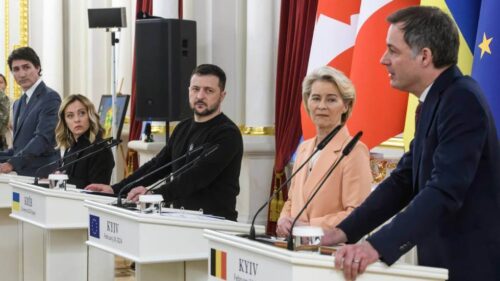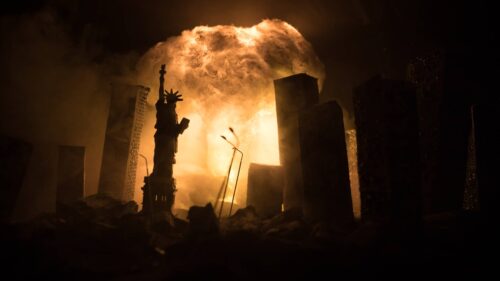Following Israel’s attack on Iranian energy facilities on October 26, 2024, Iran vowed to respond with “all available tools,” sparking fears it could soon produce a nuclear weapon to pose a more credible threat. The country’s breakout time — the period required to develop a nuclear bomb — is now estimated in weeks. Tehran could proceed with weaponization if it believes itself or its proxies are losing ground to Israel.
Iran isn’t the only nation advancing its nuclear capabilities in recent years. In 2019, the United States withdrew from the Intermediate-Range Nuclear Forces Treaty (INF), which banned intermediate-range land-based missiles, citing alleged Russian violations and China’s non-involvement. The US is also modernizing its nuclear arsenal, with plans to deploy nuclear weapons in more NATO states and proposals to extend its nuclear umbrella to Taiwan.
Russia, too, has intensified its nuclear posture, expanding nuclear military drills and updating its nuclear policies on first use. In 2023, the nation suspended participation in the New Strategic Arms Reduction Treaty (New START), which limited US and Russian-deployed nuclear weapons and delivery systems. In 2024, it stationed nuclear weapons in Belarus. Russia and China have also deepened their nuclear cooperation, setting China on a path to rapidly expand its arsenal, as nuclear security collaboration with the US has steadily diminished over the past decade.
The breakdown of diplomacy and rising nuclear brinkmanship among major powers are heightening nuclear insecurity among themselves, but also risk spurring a new nuclear arms race. Alongside Iran, numerous countries maintain the technological infrastructure to quickly build nuclear weapons. Preventing nuclear proliferation would require significant collaboration among major powers, a prospect currently out of reach.
The US detonated the first nuclear weapon in 1945, followed by the Soviet Union in 1949, the United Kingdom in 1952, France in 1960 and China in 1964. It became evident that with access to uranium and enrichment technology, nations were increasingly capable of producing nuclear weapons. Though mass production and delivery capabilities were additional hurdles, it was widely expected in the early Cold War that many states would soon join the nuclear club. Israel developed nuclear capabilities in the 1960s, India detonated its first bomb in 1974 and South Africa built its first by 1979. Other countries, including Brazil, Argentina, Australia, Sweden, Egypt and Switzerland, pursued their own programs.
However, the Non-Proliferation Treaty (NPT), enacted in 1968 to curb nuclear spread, led many countries to abandon or dismantle their programs. After the end of the Cold War and under Western pressure, Iraq ended its nuclear program in 1991. In a historic move, South Africa voluntarily dismantled its arsenal in 1994. Kazakhstan, Belarus and Ukraine relinquished the nuclear weapons they inherited after the collapse of the Soviet Union by 1996, securing international security assurances in exchange.
Nuclear proliferation appeared to be a waning concern, but cracks soon appeared in the non-proliferation framework. Pakistan conducted its first nuclear test in 1998, followed by North Korea in 2006, bringing the count of nuclear-armed states to nine. Since then, Iran’s nuclear weapons program, initiated in the 1980s, has been a major target of Western non-proliferation efforts.
Nuclear ambitions in the Middle East, Asia and Europe
Iran has a strong reason to persist. Ukraine’s former nuclear arsenal might have deterred Russian aggression in 2014 and 2022. Elsewhere, revolutionary Muammar Gaddafi, who dismantled Libya’s nuclear program in 2003, was overthrown by a NATO-led coalition and local forces in 2011. If Iran achieves a functional nuclear weapon, it will lose the ability to leverage its nuclear program as a bargaining chip to extract concessions in negotiations. While a nuclear weapon will represent a new form of leverage, it would also intensify pressure from the US and Israel, both of whom have engaged in a cycle of escalating sometimes deadly confrontations with Iran and its proxies over the past few years.
An Iranian nuclear arsenal could also ignite a nuclear arms race in the Middle East. Its relations with Saudi Arabia remain delicate, despite the 2023 détente brokered by China. Saudi officials have indicated they would obtain their own nuclear weapon if Iran acquired them. Saudi Arabia gave significant backing to Pakistan’s nuclear weapons program, with the understanding that Pakistan could extend its nuclear umbrella to Saudi Arabia, or even supply the latter with one upon request.
Turkey, which hosts US nuclear weapons through NATO’s sharing program, signaled a policy shift in 2019 when Turkish President Recep Tayyip Erdoğan criticized foreign powers for dictating Turkey’s ability to build its own nuclear weapon. Turkey’s growing partnership with Russia in nuclear energy could meanwhile provide it with the enrichment expertise needed to eventually do so.
Middle Eastern tensions are not the only force threatening non-proliferation. Japan’s renewed friction with China, North Korea and Russia over the past decade has intensified Tokyo’s focus on nuclear readiness. Although Japan developed a nuclear program in the 1940s, it was dismantled after World War II. Japan’s breakout period, however, remains measured in months. Despite this, public support for nuclear weapons remains low, given the legacy of Hiroshima and Nagasaki, where nuclear bombings in 1945 killed more than 200,000 people.
In contrast, around 70% of South Koreans support developing nuclear weapons. South Korea’s nuclear program began in the 1970s but was discontinued under US pressure. However, North Korea’s successful test in 2006 and its severance of economic, political and physical links to the South in the past decade, coupled with the abandonment of peaceful reunification in early 2024, have again raised the issue in South Korea.
Taiwan pursued a nuclear weapons program in the 1970s, which similarly ended under US pressure. Any sign of wavering US commitment to Taiwan, together with China’s growing nuclear capabilities, could prompt Taiwan to revive its efforts. Though less likely, territorial disputes in the South China Sea could also motivate countries like Vietnam and the Philippines to consider developing nuclear capabilities.
Russia’s war in Ukraine has also had significant nuclear implications. Ukrainian President Volodymyr Zelenskyy recently suggested to the European Council that a nuclear arsenal might be Ukraine’s only deterrent if NATO membership is not offered. Zelenskyy later walked back his comments after they ignited a firestorm of controversy. Yet if Ukraine feels betrayed by its Western partners — particularly if it is forced to concede territory to Russia — it could spur some factions within Ukraine to attempt to secure nuclear capabilities.
The war has also spurred nuclear considerations across Europe. In December 2023, former German Foreign Minister Joschka Fischer endorsed a European nuclear deterrent. Donald Trump’s re-election in the 2024 US presidential election could amplify European concerns over US commitments to NATO, with France having increasingly proposed an independent European nuclear force in recent years.
Nuclear collaboration
Established nuclear powers are unlikely to welcome more countries into their ranks. But while China and Russia don’t necessarily desire this outcome, they recognize the West’s concerns are greater, with Russia doing little in the 1990s to prevent its unemployed nuclear scientists from aiding North Korea’s program.
The US has also previously been blindsided by its allies’ nuclear aspirations. US policymakers underestimated Australia’s determination to pursue a nuclear weapons program in the 1950s and 1960s, including covert attempts to obtain a weapon from the UK. Similarly, the US was initially unaware of France’s extensive support for Israel’s nuclear development in the 1950s and 1960s.
Smaller countries are also capable of aiding one another’s nuclear ambitions. Argentina offered considerable support to Israel’s program, while Israel assisted South Africa’s. Saudi Arabia financed Pakistan’s nuclear development and Pakistan’s top nuclear scientist is suspected of having aided Iran, Libya and North Korea with their programs in the 1980s.
The slippery slope to nuclear conflict
Conflicts involving nuclear weapons states are not without precedent. Egypt and Syria attacked nuclear-armed Israel in 1973 and Argentina faced a nuclear-armed UK in 1982. India and China have clashed over their border on several occasions. Ukraine continues to resist Russian aggression. But conflicts featuring nuclear countries invite dangerous escalation, and the risk grows if a nation with limited conventional military power gains nuclear capabilities; lacking other means of defense or retaliation, it may be more tempted to resort to nuclear weapons as its only viable option.
The costs of maintaining nuclear arsenals are already steep. In 2023, the world’s nine nuclear-armed states spent an estimated $91.4 billion managing their programs. But what incentive do smaller countries have to abandon nuclear ambitions entirely, especially when they observe the protection nuclear weapons offer and witness the major powers intensifying their nuclear strategies?
Obtaining the world’s most powerful weapons may be a natural ambition of military and intelligence sectors, but it hinges on the political forces in power as well. In Iran, moderates could counterbalance hardliners, while continued support for Ukraine might prevent more nationalist forces from coming to power there.
Yet an additional country obtaining a nuclear weapon could set off a cascade of others. While larger powers are currently leading the nuclear posturing, smaller countries may see an opportunity amid the disorder. The limited support for the Treaty on the Prohibition of Nuclear Weapons, in effect since 2021, coupled with the collapse of other international treaties, reinforces the lingering allure of nuclear arms even among non-nuclear states. With major powers in open contention, the barriers to nuclear ambitions are already weakening, making it ever harder to dissuade smaller nations from pursuing the ultimate deterrent.
[Economy for All, a project of the Independent Media Institute, produced this piece.]
The views expressed in this article are the author’s own and do not necessarily reflect Fair Observer’s editorial policy.
Support Fair Observer
We rely on your support for our independence, diversity and quality.
For more than 10 years, Fair Observer has been free, fair and independent. No billionaire owns us, no advertisers control us. We are a reader-supported nonprofit. Unlike many other publications, we keep our content free for readers regardless of where they live or whether they can afford to pay. We have no paywalls and no ads.
In the post-truth era of fake news, echo chambers and filter bubbles, we publish a plurality of perspectives from around the world. Anyone can publish with us, but everyone goes through a rigorous editorial process. So, you get fact-checked, well-reasoned content instead of noise.
We publish 2,500+ voices from 90+ countries. We also conduct education and training programs
on subjects ranging from digital media and journalism to writing and critical thinking. This
doesn’t come cheap. Servers, editors, trainers and web developers cost
money.
Please consider supporting us on a regular basis as a recurring donor or a
sustaining member.
Will you support FO’s journalism?
We rely on your support for our independence, diversity and quality.








Comment